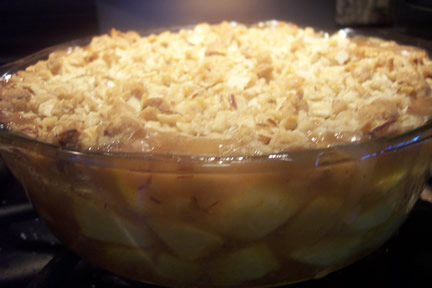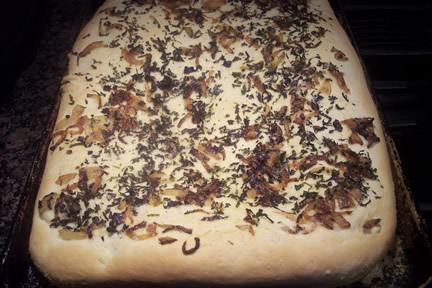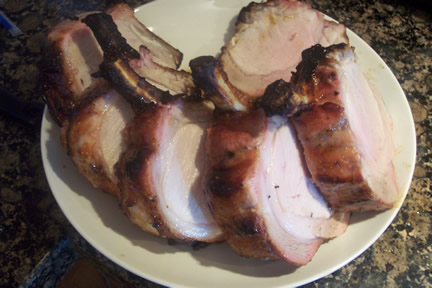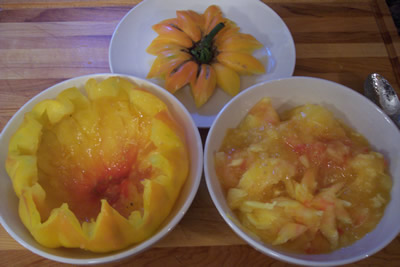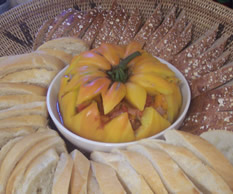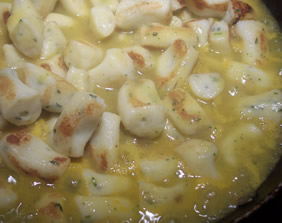This weekend was quite busy, so Sunday dinner became a bit of an afterthought. Saturday I was out all day helping my friend and former sous chef Jeff van Geest cater a wedding for some dear friends of ours, Gary and Naty King from Hazelmere Organic Farms, whose eldest daughter (one of a set of twins, I might add) was getting married, with the reception being held at the family farm. I had gone out the day before for some advance preparation, and most of the food was being prepared and brought in from the restaurant, but an early day was still in order to prepare for the 180 guests. Jeff and I were out early, getting things organized, doing some of the final details, and conversing on the logistics of the afternoon. There was over 50 lb of bison that had been marinated and sent down from Fort St. John, 4 large spring salmon, and 50 chickens, which had been quartered. deboned, and marinated in an apricot five spice barbecue sauce that Jeff had made. 180 pounds of charcoal, 2 large barbecues, plus 2 gas grills were at the ready, so all was looking fine.

Around noon, the mother of the bride came into the kitchen with some troubling news: the pastry chef who had made the wedding cake had run out of time and had not prepared a special cake for the bride, who has wheat and dairy allergies. “Maybe he’s joking?” I asked, but was reassured that it was no jest. “Ok, what do you have? Chocolate, nuts, dried fruit, eggs? Bring me some of everything and we’ll make it happen,” I assured. I figured to make a collapsed chocolate souffle of sorts, making a batter with chocolate, eggs, and sugar, and then adding a large quantity of ground nuts to keep it from rising too much and making a nice dense torte. Dried fruit would make a nice compote for a sauce, and all order would be restored. The ingredients arrived from the barn, 70% organic chocolate, a dozen eggs, a pound of organic hazelnuts, and a cup of dried cherries. A springform pan was rustled up, lightly oiled with some hazelnut oil, and set to rest. The nuts went into the oven for a light roasting to remove their skins, once done they were transferred to the freezer to cool quickly. I put hot water in a large pot,and brought it up to a boil, turned it off, and chopped the chocolate into a bowl to set on top. The eggs were separated, yolks in one bowl with some sugar, whites in another for the Kitchen Aid. Yolks whisked to ribbon stage, I added the melted chocolate, whipped the whites and folded them in. The hazelnuts, now cooled were quickly rubbed and skins removed, processed into a coarse meal in the food processor, and after I grabbed a half cup for an impromptu crust, the rest folded into the batter. Into the oven at 375, check it in 35 minutes, I thought, and then popped together the compote quickly with a simple syrup, some spices, and the cherries.

Balance restored to the Force, we returned our thoughts to dinner, and carried on with the afternoon. The fire was stoked, bison and chicken grilled and cared for lovingly, salmon was baked with a delicious hazelnut basil pesto, a few nice salads and vegetables from the farm, and the rest of the evening went off without a hitch. The bride was happy and none the wiser about the cake mishap, and we settled in to enjoy the festivities once it was all over, which bring us to Sunday.

Still feeling somewhat groggy from the previous night’s festivities, Sunday’s meal preparations became a quick and easy decision: A simple grilled steak and baked potato with some green beans for dinner, and a beef stew to prepare for Monday, so we could eat quickly after our son’s football game. A quick survey of the fridge: lots of carrots and sweet onions from the market still, needed some celery and other vegetables for the stew; steak, potatoes, and mushrooms needed for dinner. A quick trip to the produce store and butcher yielded the necessary provisions, and I set about for a quick and easy afternoon prep session. A couple of pounds of beef stew, seasoned nicely, floured and seared to a nice brown; the onion, celery, carrot, and turnip sauteed until just a touch of colour was present; and then a can of diced tomatoes, a bit of stock and herbs, and left to simmer for the afternoon. No recipes necessary for the steak: a serious rubdown with steak spice, coarse salt, and olive oil, a quick flash in the grill pan and into a hot oven to finish alongside the baked potatoes; a splash of olive oil into a couple of pans to saute a thinly sliced Walla Walla onion and some mushrooms to accompany (cooked separately to appease our resident mushroom hater) and the beans trimmed and plunged in boiling water. A satisfying repast, devoured quietly, and nothing left over. Success in its simplest form. The clan fed, stew turned off for tomorrow, to be joined by some bread or quick biscuits, and Dad was off to see legendary guitar god Steve Vai play at the Commodore.
Around midnight, I returned, both thoroughly inspired and amazed by the 3 hours of unrelenting instrumental heroics of the entire ensemble, I placed the cooled stew in the fridge to be enjoyed tomorrow, and toddled off to bed.
(special thanks to Simon Blackwell for not only his expert help, but with the fine pictures as well)





